Eglin Field
(A section of the NICEVILLE, FLORIDA - Online History Center)
"Never tell people how to do things. Tell them what to do and they will surprise you with their ingenuity."
~ George S. Patton
BOMBING AND GUNNERY RANGE, WHITE POINT
History of the Air Corps Tactical School, 1920-1940;
Chapter 3 notes, page 91
In
the summer of 1935 a bombing and gunnery range was established near Valparaiso,
Florida. Each autumn thereafter, through 1939, the entire student body spent two
or more weekends at the range to engage in bombing and gunnery exercises. For
the next three years the students spent an entire week in April or May at the
range to carry out exercises which included field training in the courses on
staff duties and navigation. Ltr, Lt Col Win. Ord Ryan to CG 4th Corps Area, 17
Jun 35, and 1st, 2d, 3d, and 4th inds, in 145.91-367; A History of
Maxwell Field, 1910-1938, pp. 166-67; Annual Rpts, ACTS, 1936-39.
Provided by: Federal Writers' Project of the Works Progress
Administration. - 1938
In 1936 the Federal government established an Army airport
at White Point on the north shore of Choctawhatchee Bay, with an eight-way
landing field. This is used for gunnery practice by the Army Air Corps
and for training of National Guard flying units.
Okaloosa News Journal, September 17, 1937:
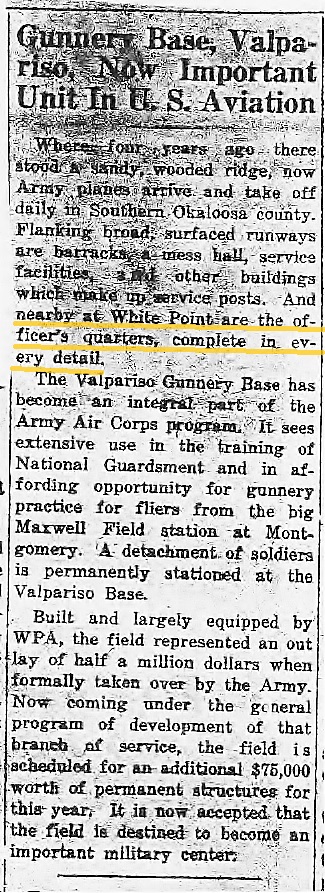
Air corps News Letter Vol 19, page 10, October 1, 1937; "EGLIN FIELD"
Bombing and Gunnery Base at Valparaiso,
Florida, which is a part of the Headquarters and Headquarters Squadron of the
Air Corps Tactlca1 School. Maxwell Field, Ala., has been
redesignated "Eglin Field," Valparaiso,
Florida, in honor of Lieut. Colonel Frederick I. Eglin, Air Corps, who was
killed in an airplane accident near Fort McClellen, Alabama, on January 1, 1937.
Air Corps New Letter, Vol 23, page 4, December 1, 1937; "VARIED
PROGRAMS FOR TACTICAL SCHOOL STUDENTS"
The
annual visits to the Valparaiso Bombing and Gunnery Base were marred by very
unseasonable weather. The first section of the class flew down October 14th for
two days of machine gun firing and a chilly north wind followed closely on the
tail of the formations. Due the shortness of the stay,
the students were housed in tents at
the flying field instead of being quartered in the cottages at White Point. (Note: White Point is in Niceville) The unseasonable weather caught the
Valparaiso Detachment unawares, and no stoves had been install in the tents.
However, bales of blankets were broken, and most of the students managed to keep
fairly warm, the weight under which they slept left most of them tired the
following morning.
Maxwell Student Housing, White Point, Niceville, Florida:
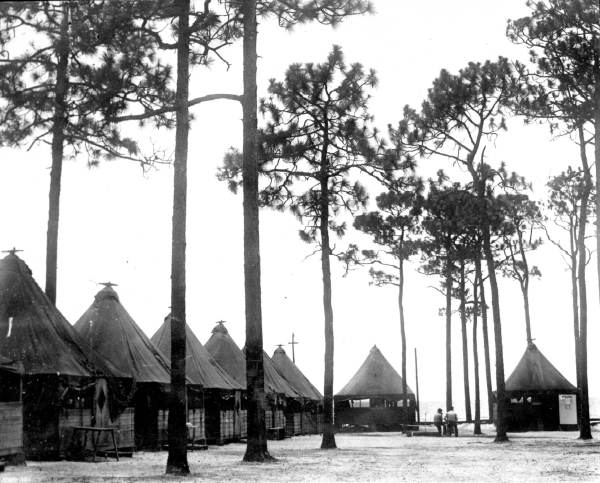
Okaloosa News Journal, page 12, Thursday December 1, 1955
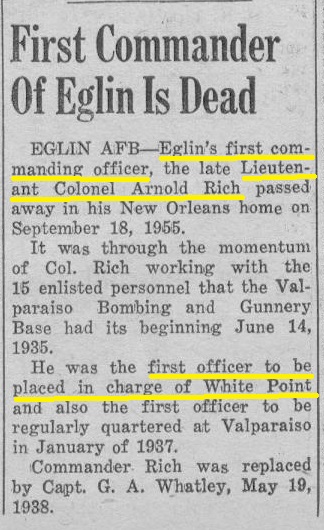
CIVILIAN CONSERVATION CORPS ARMY CAMP 1413 RELOCATED IN 1940 TO NICEVILLE
CCC Camp 1413 Army-1 at Niceville: (Note: This CCC camp was relocated to Niceville on 10/01/1940 as project 1413 Army-1. It was organized and previously located in Homerville, GA. Most of the members were from GA. Some members stayed on in the area after leaving the CCC. Camp 1413 Army-1 was located on the previous site of CCC Camp 1402. The purpose of moving Army Camp 1413 to Niceville was to begin the development of what is now Eglin Air Force Base.)
Oral
History Interview of William H. McDonald, Camp 1413:
William was born November 26, 1921. He joined the CCC in Albany, Georgia and from there
he went to Ft. McPherson then to Medford, Oregon for one year by coal burner
(train) via Denver. He said he could look at the scenery when the cinders
weren't in his eyes. From Medford he was sent to Camp 1413 at Homerville,
Georgia and then the entire camp moved to Niceville in 1940. There he worked as the
switchboard operator and truck driver and helped clear the landing field for Eglin Air
Force Base. When he got out of the CCC he worked for the Army Air Corps at Eglin
for about six months, then joined the Navy for thirty years.
(Source: Interviewed by Madeleine Carr - Florida Archives)
William H. Herndon, Niceville
Resident and Former Member of CCC Camp 1413:
"At eighteen years of age Bill Herndon enlisted in the Civilian Conservation
Corp, left his parent's home in Calhoun County,
Florida, and was sent to the CCC camp at Niceville, Florida. God blessed
Mr. Herndon with the entertaining gift of storytelling, and he enjoyed talking
about his early years in the CCC. He was a wealth of information about the
Choctawhatchee National Forestry Service. He also had the distinction of being
among the original group of men who transferred from the forestry service to
Eglin Air Force Base's Jackson Guard." (Source: Post by Jo Nagel)
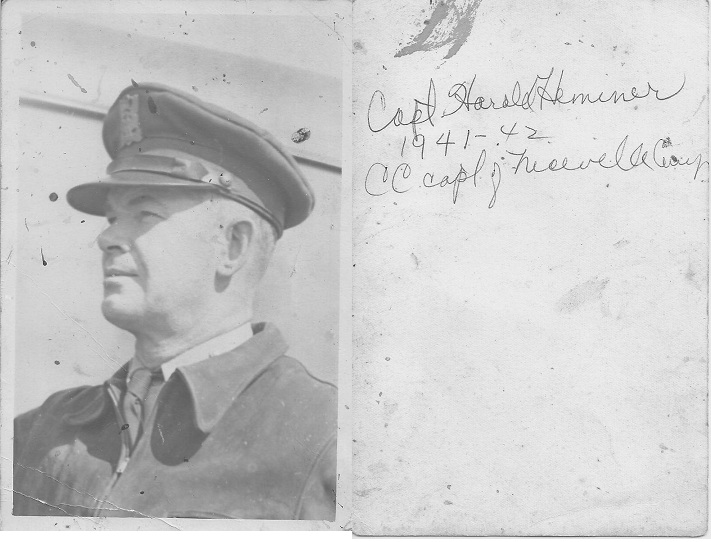
Niceville: (Source: The Valpariso News and West Florida Review, February 22, 1941)
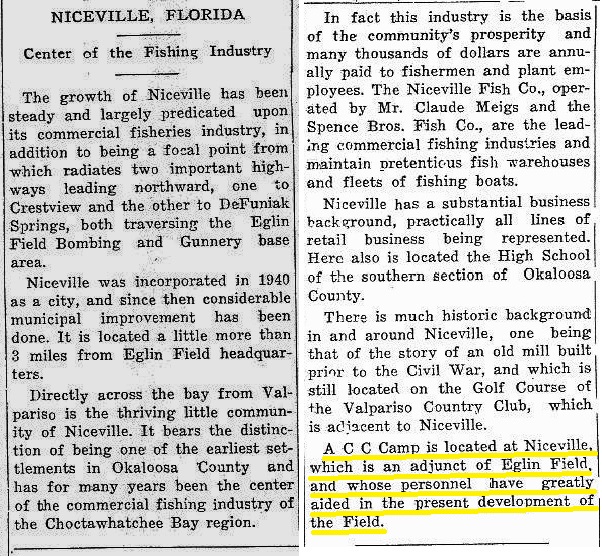
1940 CENSUS REPORTING THE U.S. ARMY AIR PORT (EGLIN FIELD) PERSONNEL AT NICEVILLE
1940 Niceville Federal Census, Election District 14, U. S. Army Air Port (Eglin Field). (Note: Below is a portion of Enumeration District 46-18 that lists Eglin Field personnel at Niceville. The census was enumerated by James S. Faircloth, Clerk on June 24, 1940 (transcribed by Jim Young in May 2012). The 'R' under City represents a community with a population of less than 2500. They may have lived in the CCC barracks, Niceville after Company 1402 moved from Niceville to Otter Creek, Florida in October of 1939. Company 1413 (see above) relocated from Homerville, Georgia to Niceville, October 1, 1940.)
| Name | Age | Marital | Birth Place | City, County, State Living 1935 | Occupation | Industry |
|---|---|---|---|---|---|---|
| Maxwell, Warren A., | 51, | M, | Indiana, | R, ---, Michigan, | Officer | U.S. Army |
| Drumm, John R., | 51, | M, | Pennsylvania, | R, Bexar, Texas, | Officer | U.S. Army |
| Gaspard, George W., | 38, | M, | Minnesota, | Maxwell Field, Montgomery, Alabama, | 1st Sergeant | U.S. Army |
| Hobbs, Fred, | 37, | M, | Georgia, | Honolulu, ---, Hawaii, | Cabinet Maker | U.S. Army |
| Milburn, Albert, | 36, | M, | Georgia, | Maxwell Field, Montgomery, Alabama, | Supply Sergeant | U.S. Army |
| Rhodes, Norval F., | 31, | M, | Alabama, | R, Montgomery, Alabama, | Aviation Mechanic | U.S. Army |
| Rustin, Frank H., | 38, | D, | Georgia, | R, Montgomery, Alabama, | Mechanic, | U.S. Army |
| Cheek, Tommie, | 31, | S, | Texas, | R, ---, Canal Zone, | Boat Operator, | U.S. Army |
| Deaux, Robert L., | 28, | M, | Alabama, | R, Montgomery, Alabama, | Boat Operator, | U.S. Army |
| Evans, Jim A., | 29, | M, | Alabama, | R, Montgomery, Alabama, | Armorer, | U.S. Army |
| Lee, Frank S. Jr., | 28, | M, | Tennessee, | R, Montgomery, Alabama, | Aviation Mechanic | U.S. Army |
| Meadows, Stanley I, | 24, | M, | Mississippi, | Raleigh, Smith, Mississippi, | Clerk | U.S. Army |
| Pearson, George P., | 28, | M, | Alabama, | Tallassee, Talapoosa, | Clerk | U.S. Army |
| Wiginton, William K., | 31, | S, | Alabama, | R, Bexar, Texas, | Mess Sergeant | U.S. Army |
| Bensley, Lyman C., | 32, | S, | Michigan, | Ft. Benning, ---, Georgia, | Plumber | U.S. Army |
| Cheek, Archie B., | 22, | S, | Alabama, | Birmingham, Jefferson, Alabama, | Painter | U.S. Army |
| Faircloth, James S, | 25, | S, | Alabama, | Troy, Pike, Alabama, | Clerk | U.S. Army |
| Gardner, Henry L., | 43, | M, | Alabama, | R, Montgomery, Alabama, | Tractor Driver | U.S. Army |
| Lathan, Noel, O.E., | 24, | S, | So. Carolina, | York, York, South Carolina, | Clerk | U.S. Army |
| McCain, Edward A., | 25, | S, | Alabama, | Ft. Benning, Chattahoochee, Georgia, | Barber | U.S. Army |
| Mills, Rupert L., | 26, | S, | Florida, | Pensacola, Escambia, Florida, | Boat Mechanic | U.S. Army |
| Wilson, Forrest E., | 32, | S, | Florida, | R, Alaqua, Florida, | Clerk | U.S. Army |
| Booth, Auxier, | 21, | ;S, | Kentucky, | R, Martin, Kentucky, | Clerk | U.S. Army |
| Boyer, Albert D., | 20, | S, | Alabama, | R, Elmore, Alabama, | Clerk | U.S. Army |
| Briles, Walter W., | 21, | S, | Kansas, | R, Lake, Florida, | Mechanic | U.S. Army |
| Carlan, Dewitt D., | 24, | S, | Georgia, | R, Banks, Georgia, | Telephone Operator | U.S. Army |
| Carter, Howard, | 21, | S, | Mississippi, | Hattisburg, Forrest, Mississippi, | Truck Driver | U.S. Army |
| Clark, Leslie, E., | 30, | S, | Alabama, | R, Baldwin, Alabama, | Plumber, | U.S. Army |
| Duthe, Arnold H., | 20, | M, | New York, | Royal Oak, Oakland, Michigan, | Truck Driver | U.S. Army |
| Edwards, Elton L., | 23, | S, | Alabama, | Gadsden, Baldwin, Alabama, | Clerk | U.S. Army |
| Eiland, Leonard M., | 23, | S, | Alabama, | Clanton, Chilton, Alabama, | Clerk | U.S. Army |
| Felton, James E. | 23, | S, | Alabama, | R, Montgomery, Alabama, | Mechanic | U.S. Army |
| Frantz, Eugene W. | 24, | M, | Arkansas, | Van Buren, Crawford, Arkansas, | Soldier | U.S. Army |
| Garcia, Tony A., | 24, | D, | Oklahoma, | Perry, Noble, Oklahoma, | Truck Driver | U.S. Army |
| Gent, John T., | 50, | M, | Rhode Island | Pensacola, Escambia, Florida, | Carpenter | U.S. Army |
| Gordon, Elmer D., | 31, | D, | Florida, | R, Okaloosa, Florida, | Boat Operator | U.S. Army |
| Huffman, Clyde D., | 23, | S, | Mississippi, | R, Attala, Mississippi, | Clerk | U.S. Army |
| Johnson, William H., | 24, | M, | Alabama, | Tallassee, Elmore, Alabama, | Carpenter | U.S. Army |
| Kennedy, Carvel E., | 22, | S, | Alabama, | Haleyville, Winston, Alabama, | Clerk | U.S. Army |
| Knupp, Howard W., | 30, | S, | Virginia, | Washington, Washington, Pennsylvania, | Soldier | U.S. Army |
| Mayton, James O., | 21, | S, | Alabama, | R, Marengo, Alabama, | Carpenter | U.S. Army |
| Moore, Raleigh L., | 22 | S, | So. Carolina, | Seneca, Oconee, South Carolina, | Truck Driver | U.S. Army |
| Murphy, Woodrow, | 25, | S, | Alabama, | Brewton, Escambia, Alabama, | Soldier | U.S. Army |
| Scott, Elmer J., | 21, | S, | Missouri, | R, Jasper, Missouri, | Soldier | U.S. Army |
| Spencer, John W., | 22, | S, | Kentucky, | Stearns, McCreary, Kentucky, | Tractor Driver | U.S. Army |
| Steger, Jefferson, | 23, | S, | Alabama, | R, Winston, Alabama, | Soldier | U.S. Army |
| Stephen, Herman R., | 26, | S, | Tennessee, | Ft. Bragg, ---, North Carolina, | Cook | U.S. Army |
| Veal, Johnnie E., | 27, | S, | Georgia, | Ft. Meade, Ann Arundel, Maryland, | Mechanic | U.S. Army |
| Ward, Earl V., | 21, | S, | Georgia, | Atlanta, Fulton, Georgia, | Carpenter | U.S. Army |
| Wackerle, Alois J., | 29, | S, | Alabama, | R, Montgomery, Alabama, | Cook | U.S. Army |
| Winters, Dewey, | 21, | M, | Alabama, | R, Franklin, Alabama, | Cook | U.S. Army |
| Anderson, Stephen F., | 20, | S, | Florida, | Tallahassee, Leon, Florida, | Carpenter | U.S. Army |
| Andrews, Ralph B., | 21, | S, | Alabama, | New Bracton, Coffee, Alabama, | Aviation Mechanic | U.S. Army |
| Baker, Alfred S., | 19, | S, | Alabama, | Enterprise, Coffee, Alabama, | Soldier | U.S. Army |
| Barnes, Louie J. Jr., | 20, | S, | Alabama, | R, Etowah, Alabama, | Soldier | U.S. Army |
| Beaulieu, Peter C., | 18, | S, | Louisiana, | New Orleans, Orleans, Louisiana, | Carpenter | U.S. Army |
| Blanton, Robert R., | 23, | S, | Alabama, | R, Marshall, Alabama, | Cook | U.S. Army |
| Carter, Johnie L., | 19, | S, | Arizona, | R, Washington, Louisiana, | Telephone Operator | U.S. Army |
| Cawthon, Howard W., | 23, | S, | So. Carolina, | R, ---, South Carolina, | Soldier | U.S. Army |
| Childers, Judie N., | 22, | S, | Alabama, | R, Winston, Alabama, | Soldier | U.S. Army |
| Clayton, Charles K., | 19, | S, | Kentucky, | Falmouth, Pendleton, Kentucky, | Soldier | U.S. Army |
| Coker, George J., | 28, | S, | Florida, | R, Smith, Mississippi, | Carpenter | U.S. Army |
| Cole, Edward J., | 20, | S, | Alabama, | Mobile, Mobile, Alabama, | Soldier | U.S. Army |
| Endicott, Emery R., | 21, | S, | West Virginia | R, ---, West Virginia, | Soldier | U.S. Army |
| Estes, James A. III, | 21, | S, | Alabama, | Washington, ---, D.C., | Electrician | U.S. Army |
| Evana, Jeff W., | 24, | D, | Mississippi, | Gulfport, Harrison, Mississippi, | Truck Driver | U.S. Army |
| Facundus, Julious A., | 22, | S, | Louisiana, | Baton Rouge, W. Baton Rouge, Louisiana | Clerk | U.S. Army |
| Ford, Daly M., | 22, | S, | Alabama, | Birmingham, Jefferson, Alabama, | Soldier | U.S. Army |
| Franklin, William D., | 20, | S, | Alabama, | Huntsville, Madison, Alabama, | Soldier | U.S. Army |
| Frost, George V., | 20, | S, | Alabama, | Haleyville, Winston, Alabama, | Cabinet Maker | U.S. Army |
| Hammack, Joseph W., | 24, | S, | Mississippi, | R, Madison, Mississippi, | Mechanic | U.S. Army |
| Hicks, Layden P., | 22, | S, | Alabama, | R, Chilton, Alabama, | Painter | U.S. Army |
| Hitt, William H., | 22, | S, | Georgia, | R, Pickens, Georgia, | Carpenter | U.S. Army |
| Howard, Dennis A.,Jr., | 20, | S, | Alabama, | R, Lauderdale, Alabama, | Soldier | U.S. Army |
| Hughes, William S., | 32, | D, | Alabama, | ---, ---, Argentina, | Boat Navigator | U.S. Army |
| Hurt, Charles M., | 27, | S, | Tennessee, | R, Henry, Tennessee, | Soldier | U.S. Army |
| Hurchison, Durdette, Jr | 20, | S, | West Virginia | R, Summers, West Virginia, | Soldier | U.S. Army |
| Jackson, William H., | 20, | S, | Alabama, | R, DeKalb, Alabama, | Telephone Operator | U.S. Army |
| Kornegay, Milton E., | 19, | S, | California, | Alexandria, Rapides, Louisiana, | Soldier | U.S. Army |
| Livingston, Calvin J., | 21, | S, | Alabama, | Birmingham, Jefferson, Alabama, | Cook | U.S. Army |
| Lowe, William A., | 20, | S, | Mississippi, | R, Warren, Mississippi | Aviation Mechanic | U.S. Army |
| Lykins, Claude, | 21, | S, | Kentucky, | R, Magoffin, Kentucky, | Tractor Driver | U.S. Army |
| McGee, Clarence P. Jr. | 18, | S, | Louisiana, | New Iberia, Ibena, Louisiana, | Draftsman | U.S. Army |
| Montgomery, Hillard P. | 22, | S, | Alabama, | R, Lawrence, Alabama, | Soldier | U.S. Army |
| Moon, Henry, | 19, | S, | Alabama, | R, Madison, Alabama, | Soldier | U.S. Army |
| Murphey, Cole S., | 22, | S, | Tennessee, | R, Fayette, Tennessee | Carpenter | U.S. Army |
| Ogletree, Hubert S., | 27, | S, | Mississippi, | R, Van Zant, Texas, | Carpenter | U.S. Army |
| Purvis, Quentin, | 22, | S, | Alabama, | R, Geneva, Alabama, | Tractor Driver | U.S. Army |
| Roach, Charles S., | 20, | S, | Alabama, | R, Jackson, Alabama, | Electrician | U.S. Army |
| Robertson, Urda W., | 23, | S, | Mississippi, | R, Smith, Mississippi, | Soldier | U.S. Army |
| Runyon, Winter G., | 19, | S, | Kentucky, | Pikeville, Pike, Kentucky | Soldier | U.S. Army |
| Shenberger, Dwain A., | 19, | S, | Ohio, | R, Richland, Ohio, | Soldier | U.S. Army |
| Scott, Grandon B., | 21, | S, | Arkansas, | Wagoner, Wagoner, Oklahoma, | Cook | U.S. Army |
| Smith, Thomas R. Jr., | 21, | S, | Mississippi, | Munday, Knox, Texas, | Clerk | U.S. Army |
| Steadman, Flurr C., | 21, | S, | Alabama, | R, Lawrence, Alabama, | Soldier | U.S. Army |
| Sturm, Woodrow, W., | 22, | S, | West Virginia, | R, Summers, West Virginia, | Clerk | U.S. Army |
| Tabb, Joseph W., | 22, | S, | Georgia, | R, Stewart, Georgia, | Aviation Mechanic | U.S. Army |
| Hacker, Bob B., T | 19, | S, | Georgia, | R, Cherokee, Georgia, | Clerk | U.S. Army |
| Thompson, John W., | 23, | S, | Alabama, | R, Pike, Alabama, | Truck Driver | U.S. Army |
| Toney, Dewey C., | 24, | S, | Alabama, | R, Madison, Alabama, | Carpenter | U.S. Army |
| Ussery, William R. Jr., | 23, | S, | Georgia, | R, Rabun, Georgia, | Surveyor | U.S. Army |
| Van Horn, William E., | 20, | S, | Ohio, | Columbus, Franklin, Ohio | Cook | U.S. Army |
| Whitehead, Charles D. | 18, | S, | Mississippi, | R, Warren, Mississippi, | --- | U.S. Army |
| Wiginton, Denton C., | 20, | S, | Alabama, | R, Hamilton, Alabama, | Soldier | U.S. Army |
| Carroll, Louie E., | 39, | M, | Arkansas, | France Field, ---, Canal Zone, | Aviation Mechanic | U.S. Army |
| McLaren, Samuel T., | 32, | M, | Arkansas, | R, Montgomery, Alabama, | Aviation Mechanic | U.S. Army |
| Belesky, George M., | 31, | M, | Pennsylvania, | R, Montgomery, Alabama, | Radio Operator | U.S. Army |
| Melton, Lawrence H., | 27, | M, | Alabama, | Tallassee, Elmore, Alabama, | Soldier | U.S. Army |
| Phillips, Frederick A., | 25, | D, | Florida, | Pensacola, Escambia, Florida, | Clerk | U.S. Army |
| Moses, Homer C., | 21, | M, | Alabama, | Roanoke, Randolph, Alabama, | Clerk | U.S. Army |
| Reddoch, Gilbert C., | 21, | S, | Alabama, | Ft. Benning, Chattahoochee, Georgia | Soldier | U.S. Army |
| Wallace, James W., | 20, | S, | Tennessee, | R, Fayette, Tennessee, | Soldier | U.S. Army |
| Bennett, William H., | 28, | S, | Arkansas, | Paris, Logan, Arkansas, | Medical Officer | U.S. Army |
| Bell, Clemon S., | 47, | S, | D.C., | Atlanta, ---, Georgia, | Medical Attendant | U.S. Army |
| Bratcher, Adam F., | 23, | S, | Florida, | R, Escambia, Florida, | Medical Attendant | U.S. Army |
| Byrd, Harold F., | 32, | S, | Ohio, | R, Montgomery, Alabama, | Radio Operator | U.S. Army |
| Bowden, Adam F., | 19, | S, | Alabama, | Dothan, Houston, Alabama, | Radio Operator | U.S. Army |
| Byrd, Harold R., | 23, | S, | Georgia, | Reynolds, Taylor, Georgia, | Radio Operator | U.S. Army |
| Garrett, Ralph H., | 25, | S, | Georgia, | R, Carroll, Georgia, | Radio Operator | U.S. Army |
| Blain, John S., | 21, | S, | Indiana, | Dade, Dade, Florida, | Meteorologist | U.S. Army |
| Legare, Julian K., | 24, | S, | Alabama, | R, Greene, Alabama, | Meteorologist | U.S. Army |
| Fuller, Gilbert C., | 24, | S, | New York, | Holcomb, Ontario, New York, | Telephone Linesman | U.S. Army |
| Grizzard, Joseph F., | 29, | S, | Virginia, | Portsmouth, Norfolk, Virginia, | Ammunition Worker | U.S. Army |
| Ransom, Walter E., | 27, | S, | New York, | Kingston, Ulster, New York, | Auto Mechanic | U.S. Army |
| Jackson, Harry L., | 19, | S, | Ohio, | East Liverpool, Columbiana, Ohio, | Bomb Handler | U.S. Army |
| Kinley, Benny, | 32. | S, | Kentucky, | Honolulu, ---, Hawaii, | Ammunition Worker | U.S. Army |
| Gergely, Alexander A., | 20, | S, | Illinois, | R, Cook, Illinois, | Bomb Handler | U.S. Army |
| Lamuraglia, Toby, | 19, | S, | New York, | Seneca Falls, Seneca, New York, | Bomb Handler | U.S. Army |
| Siler, Theodore R., | 19, | S, | Kentucky, | Williamsburg, Whitley, Kentucky, | Bomb Handler | U.S. Army |
AUXILLARY LANDING FIELD #1 (WAGNER), NICEVILLE AND DOOLITTLE RAID MARKER
Wagner Field / Eglin Air Force Aux #1, Niceville, FL:
30.67 North / 86.35 West (Northeast of Eglin AFB, FL)
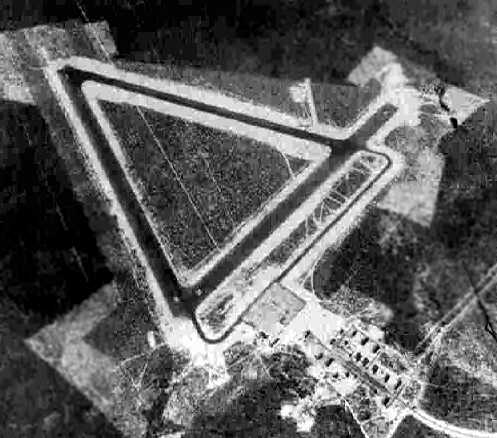
A 9/9/43 aerial view looking southwest at "Eglin Field Auxiliary #1" from the 1945 AAF Airfield Directory (courtesy of Scott Murdock).
"Wagner Field is one of numerous satellite airfields built during WWII for the use of Eglin AAF. The date of construction of Wagner Field has not been determined. According to a historical plaque (photographed by Mark Sublette in 2009) at the entrance to Eglin Aux #1, from March 9-25, 1942, Lt. Col. Jimmy Doolittle's "Raiders" secretly trained at Eglin Aux #1 for their historic carrier-based B-25 bomber raid on Japan. Their training was assisted by personnel from nearby NAS Pensacola. The earliest depiction of Wagner Field which has been located was a 9/9/43 aerial view looking southwest from the 1945 AAF Airfield Directory (courtesy of Scott Murdock). It depicted "Eglin Field Auxiliary #1" as having 3 asphalt runways in a equilateral triangle, with a taxiway leading to a ramp area at the north end of the field. There did not appear to be any hangars, but a clearing north of the ramp had a large number of buildings."
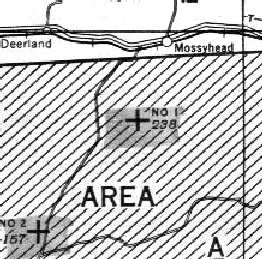
The earliest aeronautical chart depiction of Wagner Field which has been located was on the 1945 Mobile Sectional Chart (courtesy of John Voss). It depicted "#1" as an auxiliary airfield.
"The 1945 Army Airfield Directory (courtesy of Scott Murdock) described "Eglin Field Auxiliary #1" as a 450 acre irregularly-shaped property having 3 sand-bituminous runways, the longest being the 4,000' north/south & northeast/southwest strips. The field was not said to have any hangars, to be owned by the U.S. Government, and operated by the Army Air Forces."
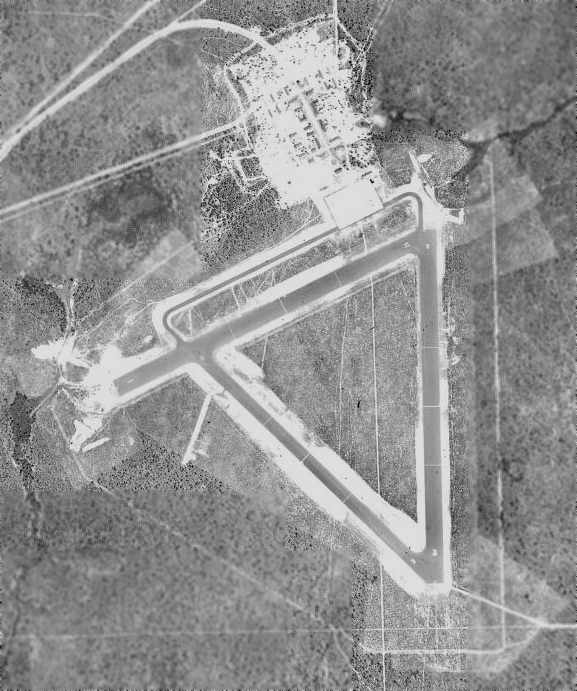
A 1949 USDA aerial photo of Eglin Aux #1, from the Digital Library Center / University of Florida George A. Smathers Libraries (courtesy of Brian Rehwinkel).
"The airfield was still in its original WWII-era configuration, with three 5,000' asphalt runways, with a taxiway leading to a ramp area at the north end of the field. There did not appear to be any hangars, but a clearing north of the ramp had a large number of buildings (or remains of buildings). Work on Auxiliary Field 1 began 27 November 1940. Auxiliary Field 1 is named Wagner Field for Maj. Walter J. Wagner, former commanding officer for the 1st Proving Ground, Eglin Field, who was killed 10 October 1943 in the crash of AT-6C-NT Texan, 41-32187, c/n 88-9677, at Auxiliary Field 2. Much Doolittle Raid and Operation Credible Sport training took place here. It is also known as Site C-5. Range C-72 extends SE from Wagner Field." (Source: Abandoned & Little Know Airfields: Florida, Eglin Area by Paul Freeman.)
Eglin commemorates 65th Anniversary of Doolittle Raid with historical marker:
"A
top-secret, two-week training initiative at Eglin Field in 1942, set in motion a
sequence of events that changed the course of the war in the Pacific during
World War II."
"To commemorate the 65th anniversary of the Doolittle Raid on Japan and the role
played by, then, Eglin Field in that secret mission, U.S. Air Force and
Congressional leaders and local Doolittle Raider, retired Master Sgt. Ed Horton,
dedicated a historical marker to the Doolittle Raiders on Wagner Field,
Auxiliary Field 1 with a three-ship B-25 Mitchell aerial demonstration at the
2007 Eglin Air Force Base Air Show April 15."
"Between March 9 and March 25, 1942, Colonel
Doolittle and 79 other crewmembers with 16 B-25 Mitchell bombers trained at
Wagner Field (Auxiliary Field 1), Eglin Field, on carrier-style short takeoffs,
assisted by U.S. Navy Lt. Henry Miller, Pensacola Naval Air Station."
"The Raiders also practiced takeoffs at Eglin main and flew low-level navigation
flights over Eglin's land and water ranges. Eglin Field personnel modified the
Doolittle B-25s to enable them to fly the long distances to reach Japan and then
China, what would become the longest combat mission in the history of the B-25."
The marker reads: "The Doolittle Raid. U.S. Army Air Force special order #1 of World War II, was a daring one-way mission of 16 B-25 Mitchell medium bombers with 80 aircrew, commanded by Lt. Col. James "Jimmy" Doolittle, to carry out America's first offensive attack on Japan.
From March 9-25, 1942, the Raiders, assisted by Naval Air Station Pensacola. Secretly trained at Eglin Main and Wagner Field, Eglin Aux Field #1. Personnel at Eglin Field also made extensive modifications to the aircraft.
On April 18, 1942, Doolittle's B-25s took off from the USS Hornet for their long overwater flight to Japan. After the attack, the Japanese captured eight crew members and executed three as was criminals. One died in captivity from sickness. In retaliation for aiding 65 Raiders to safety, the Japanese Army executed up to 250,000 Chinese. The Soviet Union interned one five-man crew after they landed their B-25 in Soviet territory.
The Raid had little tactical impact, but it did significantly raise American morale in the dark days of early 1942 and led directly to the strategic American victory at the Battle of Midway, June 5-7, 1942. It also foreshadowed the Strategic Bombing Campaign of Japan, 1944-45." (Source: Inside Eglin AFB, 4/18/2007, Staff Sgt. Mike Meares, 96th Air Base Wing Public Affairs)
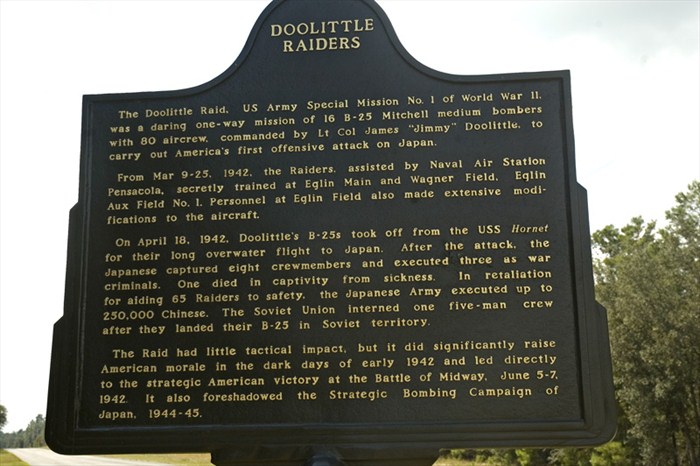
B-25B (Mitchell) medium range bomber at Eglin Field, Florida, March 27, 1942:
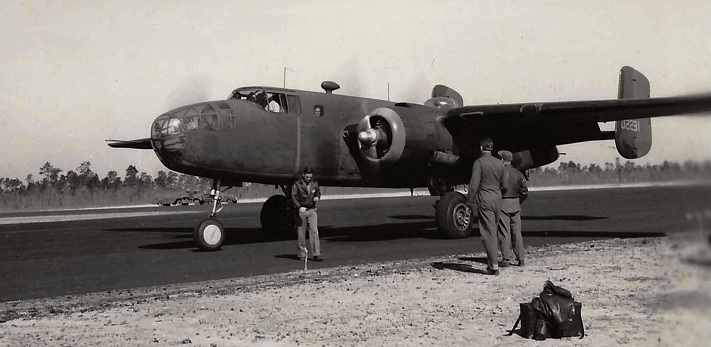
27 March 1942: "After three weeks of intensive training at (Wagner Field - Auxiliary Field 1) Eglin Field, Florida, 22 North American Aviation B-25B Mitchell twin-engine medium bombers of the 17th Bombardment Group, U.S. Army Air Force, complete a two-day low-level transcontinental flight and arrive at the Sacramento Air Depot at McClellan Field for final modifications, repairs and maintenance before an upcoming secret mission - The Doolittle Raid." (Source: Bryan Swopes, This Day in Aviation; thisdayinaviation.com)
Doolittle Raiders Highway, Niceville:
"Be It Enacted by the Legislature of the State of Florida: Section 1. Doolittle Raiders Highway designated; Department of Transportation to erect suitable markers. - (1) That portion of State Road 285 in Okaloosa and Walton Counties which is located north of College Boulevard in Niceville is designated as "Doolittle Raiders Highway." (2) The Department of Transportation is directed to erect suitable markers designating Doolittle Raiders Highway as described in subsection (1)." (Laws of Florida, Ch. 2010-230)
AUXILLARY LANDING FIELD #2 (PIERCE), NICEVILLE
Pierce Field / Eglin Air Force Aux #2 (FL35), Niceville, FL
30.58 North / 86.44 West (Northeast of Eglin AFB, FL)
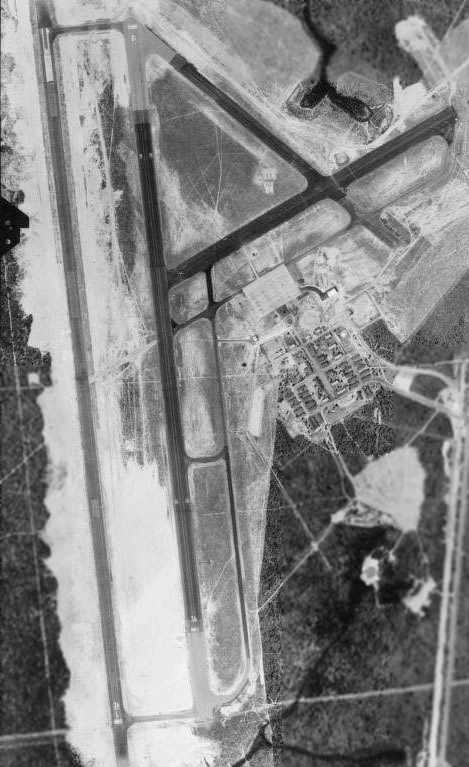
An April 14, 1955 US Government aerial photo of Eglin Aux #2 (from the University of FL online library, via Brian Rehwinkel).
"Pierce Field is one of numerous satellite airfields built during WW2 for the use of Eglin AAF. The date of construction of Pierce Field has not been determined. One of the Eglin Auxiliary airfields was used by Jimmy Doolittle in 1942 as a practice site for the short takeoff runs needed for his B-25 bomber crews to conduct their carrier-launched raid on Japan. This field may have been Pierce Field (see details paragraph below). The earliest depiction of Pierce Field which has been located was on the 1945 Mobile Sectional Chart (courtesy of John Voss)."
"Auxiliary Field 2 is named Pierce Field for Lt. Col. George E. Pierce, killed 19 January 1942 while piloting B-25C-1 Mitchell41-13118, which crashed into the Gulf of Mexico 2 miles (3.2 km) S of Destin, FloridaJoe Baugher cites date of 19 October 1942 for loss. It is also known as Site C-3. Between November 1966 and 1970, it was the site of the 560th Civil Engineering Squadron, also known as the Civil Engineering Field Activities Center, for the training of personnel." (Source: Abandoned & Little Know Airfields: Florida, Eglin Area by Paul Freeman.)
NICEVILLE SCHOOL TERM CHANGED FOR EGLIN FIELD MILITARY FAMILIES
Nine Month School Term. (Note: Children of Eglin Field military families attended the Niceville school.) (Source: Okaloosa News-Journal 03/18/1943)

A MEMBER OF THE FOREIGN LEGION: From the memoirs of JIM FAIRCLOTH, Chief Warrant Officer, W-4, USAF (Ret). (Note: According to Jim Young this is the same Faircloth that enumerated the 1940 census for U. S. Army Air Port (Eglin Field) in Election District 14 (Niceville).
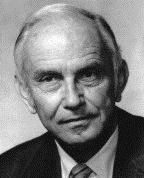
Chief Warrant Officer, W-4 USAF (Ret)
"In the pioneer days at Eglin (1935-40), we who lived in barracks, had no means of transportation. We had only one truck, used mainly for making the trip to Fort Barrancas at Pensacola to pick up standard rations for the mess hall and other items which could only be obtained in a large city. Fort Walton Beach had a permanent population of a mere 300 at that time. Our commander authorized the use of the vehicle to take us to and from such places as Crestview, Ft Walton, or Mossy Head on Saturday nights.
Other than that, it was stay in barracks or walk.
Pa Fink was the owner and operator of Fink's Place, a combination general store, hamburger and juke joint, and beer dispensary some five miles from base on Boggy Bayou near Niceville. Several of us would quite often walk there and back for an evening's entertainment. Pa Fink was glad to have our business even though most of us were in the $21 - $42 dollar a month category. There were times when we would buy a case of beer at the little Post Exchange on base (we got it much cheaper) and carry it to Fink's. Although Pa Fink didn't like it, especially when we asked him to exchange the hot beers for cold ones, he put up with it because we would spend the savings with him.
He did get angry with us when, one night, one of our company threw an empty beer bottle through the glass of the Juke box after the song "It Makes No Difference Now" had played for about the twentieth time. Pa was a heavily built fat man who wore suspenders and used a walking cane. I don't think he needed the cane, it was more of a threat to those who got out of order. After our impetuous fellow threw the beer bottle, Pa Fink raised the cane high above his head to strike our man. The suspenders broke, the pants fell, and the crowd broke out in hysterics. Including the embarrassed Pa Fink.
Joe Brusky, the Mess Sergeant was often with us on these outings. We usually wore our Air Corps work coveralls. These coveralls had large front and rear pockets, better to carry large work items. Wack, the 1st Cook, was also along with Joe. On the long way home, after several beers, our pace was laggard. Usually, about three miles into the trip, Joe would pull out of his rear pocket a large package wrapped in newspaper, unwrap it, and, behold, a large baloney sandwich, which he had made up before leaving the mess hall, would appear. Large is a conservative description. Only one who is familiar with the size of G I bread as baked and sliced before WWII can appreciate just how large. It was big!!!
Each time Joe pulled the unveiling, Wack, the cook, would raise almighty hell. "Dammit Joe, why do you pull this on us. You know we are all hungry as the devil." exclaimed Wack. Wack's words were really much stronger than that.
Joe would reply, "Why, Wack! You know I was a member of the French Foreign Legion. And we were taught never to be caught off base without at least one ration in our pocket."
Then one night while Joe was eating his sandwich Wack said, "Joe, don't ever pull this again, if you do I'm going to beat the hell out of you!"
About a week later, we had spent the evening at Fink's and were plodding homeward about midnight. Reaching the center of the bridge over the bayou between Fink's and the base, Joe stopped and very carefully unveiled the ubiquitous Baloney Sandwich.
"Joe," screamed Wack, "I told you never to do that again!"
Joe began his spiel, "Wack, I told you I was a member of the ................". With that Wack grabbed him by the seat of the pants and the scruff of his neck, lifted Joe's 140 pounds high into the air and held him out over the waters of the bayou. "Damn you Joe, I'm gonna drown you."
"Please, Wack, I can't swim!"
"Good, you'll drown quicker."
"Please!!!........................ Wack turned him loose. Splash! It soon became obvious that Joe couldn't swim. So, over the side went Wack, grabbed Joe and swam with him the fifty yards or so. We never heard Joe mention the Foreign Legion again and we all lived happily ever after." (Source: Veterans History Project.)
EGLIN BASE RAILROAD AND LUMBER PULP YARD AT NICEVILLE

"Col. George P. Kendrick, chief of installations of the Air Proving command, announced on 11 August 1949, that negotiations were underway between the U.S. Air Force and the chief of the U. S. engineers relative to salvaging railroad materials at Camp Claiborne and Camp Polk, Louisiana, the Playground News Fort Walton, Florida, reported on 18 August 1949. Kendrick stated that Third Army headquarters had indicated that the 44th Engineers Construction battalion, now in training at Fort Bragg, North Carolina, would do the work on moving the railroad materials to the new location. Although no official date had been set, an unofficial report gave 15 November as an approximate arrival date for the engineer battalion."
"The Eglin Air Force Base railroad was first constructed from an interchange with the Louisville & Nashville Railroad at Mossy Head, Florida down to the main base complex, with spurs to Auxiliary Fields 1 and 2, the ammunition dump, and other parts of the military reservation, with a total of 45 miles (72 km) of track. It was constructed with materials salvaged from the Claiborne and Polk Railroad, a 43-mile (69 km) line between the two camps, abandoned in 1945. The line, nicknamed the "B & F" (for back and forth), began operation on 1 February 1952 as part of the transportation division, Air Proving Ground Command, and utilised three ALCO RSD-1 military diesel-electric locomotives. Its first yard manager was Shelby White. Part of the base main track and spur to the ammunition dump were realigned in 1956 with the construction of the 12,000-foot-long (3,700 m) runway 32/14."
"Initial construction of a railroad line into the region had been discussed as early as 1927 as part of the Choctawhatchee and Northern Railroad, though military-use proposals didn't come forward until 1941. German POWs were used in clearing and grading the alignment during World War II. There was one commercial customer served by the line, a lumber pulp yard at Niceville which is now community athletic fields. The line was later abandoned in the late 1970s and the southern end, west of State Road 285, pulled up by the mid 1980s. Much of the tracks remain in place from the former L&N (now CSX) interchange to just south of Bob Sikes Road, about 11 miles (18 km) long, albeit overgrown. Building 538, formerly the two-track, four-engine capacity engine house, serves as the vehicle maintenance corrosion control shop in 2009. Two of its four oversize doors have been walled closed. The (by then) four RSD-1 diesels were donated to the Tennessee Valley Railroad Museum. One authoritative source on Florida railroad history has reported that steam was operated on the neophyte base railroad, but no local accounts support this." (Source: History of Eglin Air Force Base: Base Railroad, Wikipedia.)
Railroad moved to Eglin (Source: St. Petersburg Times 09/22/1950)
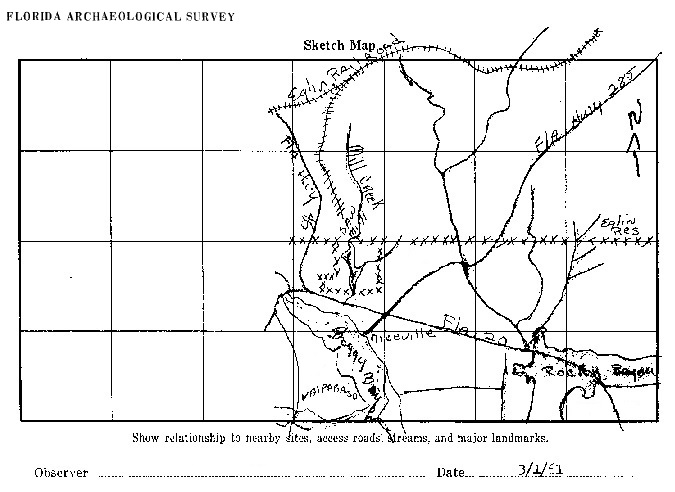
For more information on the Mossy Head to Eglin AFB railroad go to link for abandon rails.